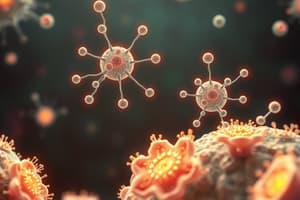Podcast
Questions and Answers
What role do second messengers play in signal transduction?
What role do second messengers play in signal transduction?
- They exclusively activate G proteins.
- They can amplify the signal and initiate different events. (correct)
- They primarily bind to extracellular receptors.
- They are always restricted to one specific role.
How are G proteins activated within the cell?
How are G proteins activated within the cell?
- By the removal of GDP.
- By the binding of adrenaline only.
- When bound to guanosine triphosphate (GTP). (correct)
- Through the addition of phosphate groups.
What occurs when a G protein binds to GTP?
What occurs when a G protein binds to GTP?
- It only affects the extracellular matrix.
- It loses its ability to bind other proteins.
- It changes shape and becomes active. (correct)
- It becomes inactivated immediately.
Which of the following describes enzyme-linked receptors?
Which of the following describes enzyme-linked receptors?
What is a key feature of signal amplification in cellular communication?
What is a key feature of signal amplification in cellular communication?
What happens to G proteins when a phosphate group is removed from GTP?
What happens to G proteins when a phosphate group is removed from GTP?
Which statement about second messengers is true?
Which statement about second messengers is true?
What is a common function of G-protein-coupled receptors?
What is a common function of G-protein-coupled receptors?
What is the primary function of neurotransmitters in cell signaling?
What is the primary function of neurotransmitters in cell signaling?
What type of molecules are hormones classified as?
What type of molecules are hormones classified as?
Where are the receptors for lipid-soluble signaling molecules found?
Where are the receptors for lipid-soluble signaling molecules found?
What happens to the number of receptors in a cell after prolonged hormonal stimulation?
What happens to the number of receptors in a cell after prolonged hormonal stimulation?
How do large or hydrophilic signaling molecules interact with target cells?
How do large or hydrophilic signaling molecules interact with target cells?
What could happen to a receptor's binding ability after intensive stimulation?
What could happen to a receptor's binding ability after intensive stimulation?
What role do beta-blockers play in cell signaling?
What role do beta-blockers play in cell signaling?
How does the same signaling molecule affect different cells?
How does the same signaling molecule affect different cells?
Flashcards are hidden until you start studying
Study Notes
Cell-Cell Communication
- Cells communicate with each other through various signaling molecules, including neurotransmitters and hormones.
- Hormones are secreted by plant and animal cells into bodily fluids and act on distant target cells.
- Hormones are usually small molecules and can be peptides, steroids, or even gases.
Signal Reception
- Signaling molecules bind to receptor molecules on the target cell, changing the receptor's shape.
- Receptors can be located inside the cell (for lipid-soluble molecules) or on the cell surface (for lipid-insoluble molecules).
Signal Receptors
- The number of receptors in a cell can decline with prolonged exposure to high levels of a signaling molecule.
- The ability of a receptor to bind tightly to a signaling molecule can also decline, affecting cell sensitivity.
- Receptors can be blocked by drugs, such as beta-blockers which bind to adrenaline receptors.
Processing Lipid-Soluble Signaling Molecules
- Lipid-soluble signaling molecules can diffuse across the plasma membrane and enter the cytosol of their target cells.
- These molecules bind to receptors located inside the cell.
Processing Lipid-Insoluble Signaling Molecules
- Lipid-insoluble signaling molecules bind to receptors on the cell surface.
Intracellular Signal Amplification and Diversification
- The signal transmitted by a hormone can be amplified as it changes form within the cell.
- This enables hormones to affect multiple molecules in the cell.
- Amplification can involve various mechanisms, leading to the generation of secondary signals that involve many ions or molecules.
Signal Transduction and Amplification Systems
- G-protein-coupled receptors produce intracellular “second messengers,” which amplify the signal.
- Enzyme-linked receptors amplify the signal by activating a series of proteins inside the cell through the addition of phosphate groups.
G-Protein-Coupled Receptors
- These receptors are associated with membrane-anchored proteins called G proteins.
- G proteins are activated when they bind GTP and inactivated when GDP replaces GTP.
- G proteins regulate the activity of other proteins involved in signal transduction.
Second Messengers
- They can initiate a variety of events in the same cell or in different cell types receiving the same signaling molecule.
- Multiple second messengers may be involved in triggering a cell’s response to the same extracellular signaling molecule.
Studying That Suits You
Use AI to generate personalized quizzes and flashcards to suit your learning preferences.




